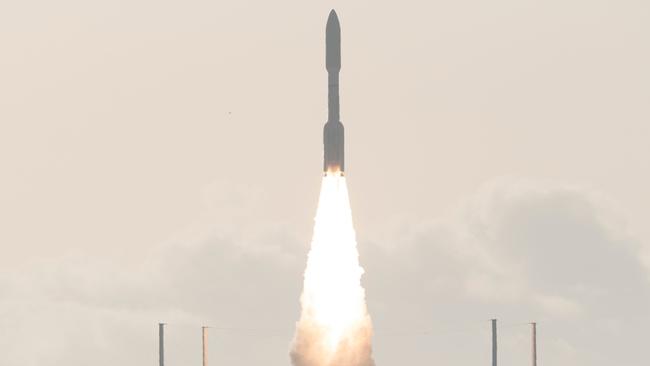Mars-bound: NASA’s life-seeking rover Perseverance launches
NASA’s latest Mars rover Perseverance launched on Thursday night on an mission to look for signs of ancient microbial life.

NASA’s latest Mars rover Perseverance launched on Thursday night AEST on an astrobiology mission to look for signs of ancient microbial life.
It will also fly a helicopter-drone on another world for the first time.
A United Launch Alliance Atlas V rocket took off on schedule at 7.50am (9.50pm AEST) from Cape Canaveral, Florida, despite a 4.2-magnitude earthquake that rattled NASA’s jet propulsion laboratory in California that manages the mission minutes earlier.
The first stage separation took place a few minutes later and Perseverance prepared for a second burn to put it on a trajectory toward Mars.
If all goes to plan, Perseverance will reach the red planet on February 18, becoming the fifth rover to complete the voyage since 1997.
All so far have been American. China launched its first Mars rover last week, which should arrive by May.
By next year, Mars could therefore have three active rovers, including NASA’s Curiosity, which has traversed 23km of the planet since it landed in 2012.
NASA chief Jim Bridenstine said the coronavirus pandemic made it even more important that the launch went ahead as planned.
“We have a history of doing amazing things in the most challenging times, and this is no different,” he said minutes before take-off.
Perseverance is an improved version of Curiosity. It is faster, with a tougher set of six wheels, has more computing power, and can autonomously navigate 200m a day.
About the size of a small SUV, it weighs a tonne, has 19 cameras, and two microphones — which scientists hope will be the first to record sound on Mars.
It has a 2m-long robotic arm, and is powered by a small nuclear battery.
Once on the surface, NASA will deploy the Ingenuity Mars Helicopter — a 1.8kg aircraft that will attempt to fly in an atmosphere that is only 1 per cent the density of Earth’s.
The idea is to lay down a proof of concept that could one day revolutionise planetary exploration, since rovers can cover only a few dozen kilometres in their whole lifespans and are vulnerable to sand dunes and other obstacles higher than 40cm.
Perseverance’s primary mission is to scour the planet for evidence of ancient life forms.
Scientists believe that more than three billion years ago the planet was much warmer than today and was covered in rivers and lakes, conditions that could have led to simple microbial life.
The reasons for it becoming the cold, barren world we know today aren’t fully known.
Another first: Perseverance’s drill will collect about 30 intact rock cores and place them in test tubes, to be collected by a future joint US-European mission.
Indisputable proof of past life on Mars will most likely not be confirmed, if it exists, until these samples are analysed next decade, NASA chief scientist Thomas Zurbuchen said this week.
“What we are looking for is likely very primitive life, we are not looking for advanced life forms that might be things like bones or fern fossils,” explained project scientist Ken Farley.
NASA has chosen the Jezero crater as its landing site, a giant impact basin just north of the Martian equator.
If conditions are harsh on the sand-swept planet where night temperatures dip to -90C, it does have one major advantage: no plate tectonic activity. On Earth, it is extremely difficult to find landscapes that have remained the same for three billion years.
More than 350 geologists, geochemists, astrobiologists, atmospheric specialists and other scientists from around the world are taking part in the mission.
It is set to last at least two years, but probably much longer given the endurance shown by previous rovers.
AFP



To join the conversation, please log in. Don't have an account? Register
Join the conversation, you are commenting as Logout